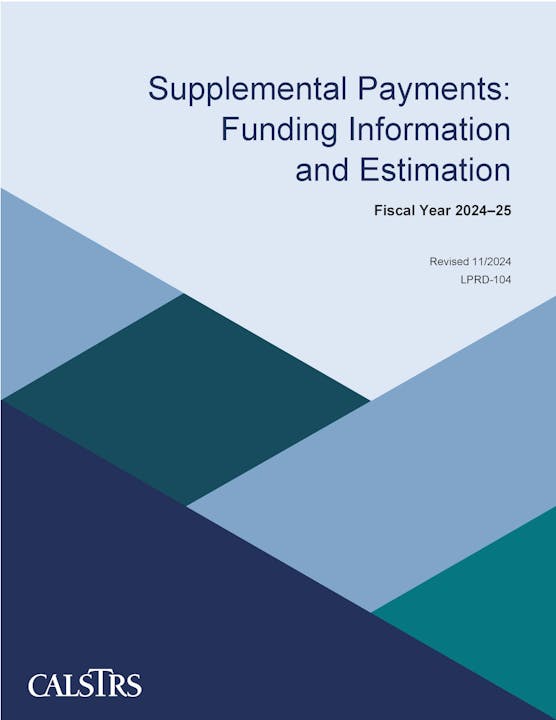Inflation protection
How does CalSTRS protect retired members from inflation?
Your CalSTRS retirement benefit has two built-in protections against inflation, but it’s important to leverage your assets and income to ensure your quality of living is as high in the future as it is today.
Annual benefit adjustment
Under California state law, you’ll receive an automatic benefit increase equal to 2% of your initial benefit beginning September 1 after the first anniversary of your retirement. Your retirement date must be before September 1 to receive the annual benefit adjustment on September 1 of the next year.
The amount of your adjustment will appear in your October 1 payment. Adjustments are not compounded or tied to changes in the cost of living.
Under the CalSTRS Funding Plan, the Legislature cannot reduce the 2% annual benefit adjustment for members who retire on or after January 1, 2014.
The annual benefit adjustment for members who retired before January 1, 2014, is not contractually guaranteed—it can be reduced or eliminated by the Legislature if economic conditions dictate. However, the Legislature has never reduced the annual benefit adjustment.
Purchasing power protection
Your retirement benefit has additional purchasing power protection. Purchasing power is a measurement of how your retirement benefit keeps pace with inflation. For example, if your benefit stays the same but prices double, your purchasing power is only 50% of its original value.
Supplemental benefit payments are paid in quarterly installments to maintain your retirement benefit's purchasing power.
CalSTRS makes these payments to retired members and beneficiaries whose benefits have fallen below a certain level of purchasing power, subject to the availability of funds. The purchasing power protection level is currently set at 85% of your initial benefit (base allowance).
Through an annual automated process, CalSTRS determines eligibility. If you are eligible, you will receive a confirmation letter and Supplemental Benefit Maintenance Account (SBMA) benefits will be paid in October, January, April and July. This payment will be separate from your regular monthly benefit, but it will be issued in the same method as your monthly benefit.
Our SBMA is one of the strongest anti-inflation programs operated by any public pension system in the nation.
Supplemental payments are not guaranteed and will continue only as long as funds are available. During periods of low inflation, your quarterly supplemental payment amount may be reduced, but your purchasing power will never drop below the protection level approved by the Teachers’ Retirement Board.
Frequently asked questions
Due to high inflation, the number of members who receive SBMA payments has increased over the past few years. Several new cohorts of retired members will begin receiving supplemental payments in October 2024.
State law requires CalSTRS to protect its members by ensuring they directly receive all the benefits they are owed.
Some of our members may receive a payment of $10 or less per quarter because their purchasing power is only slightly less than 85%. A few members may receive physical checks for these small amounts.
Because it is required, we must issue these supplemental benefit payments, no matter the amount. If you're still receiving paper checks, we encourage you to sign up for direct deposit through your myCalSTRS account.
Perhaps you know someone who retired around the same time and they are receiving a supplemental payment but you are not. Here is why:
Members who retire between September and December do not receive their annual simple benefit adjustment of 2% until October of the following year.
Members who retired in certain time periods will not receive supplemental payments this year because when they retired, the economy was in a period of either low inflation or deflation. As a result, their annual simple benefit adjustment of 2% has kept their purchasing power above 85%.
Am I eligible?
This chart shows eligibility based on retirement periods during calendar years.
Year of retirement | Retirement month: Jan.–Aug. | Retirement month: Sept–Dec. |
|---|---|---|
2007 / earlier | Yes | Yes |
2008 | No | No |
2009 | No | Yes |
2010 | Yes | Yes |
2011 | No | Yes |
2012 | No | Yes |
2013 | No | Yes |
2014 | No | No |
2015 | No | Yes |
2016 | No | Yes |
2017 / later | No | No |
Higher rates of inflation can impact the standard of living for members living on a fixed income. Inflation is generally measured by changes in the average prices of selected goods and services. As inflation rises, the value of money decreases because it purchases fewer goods and services. Higher rates of inflation can impact the standard of living for members living on a fixed income.
Inflation can also be defined as a decline in the purchasing power of money. The higher the rate of inflation, the greater the drop in the purchasing power of money.
Using California’s rate of inflation from the previous fiscal year, CalSTRS assesses the level of purchasing power for retirees after application of the annual simple benefit adjustment of 2% increase.
The change in the All-Urban California Consumer Price Index, calculated by the Division of Labor Statistics and Research in the California Department of Industrial Relations, is used for this annual assessment.
Learn more about how purchasing power and SBMA payments are calculated in the Supplemental Payments: Funding Information and Estimation publication. This publication includes worksheets to help you estimate supplemental payments.

